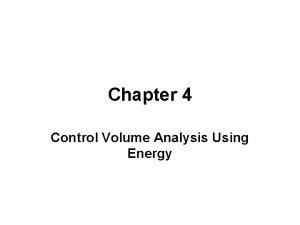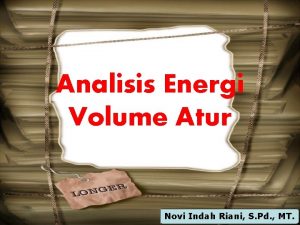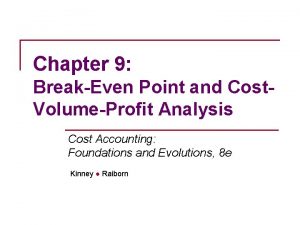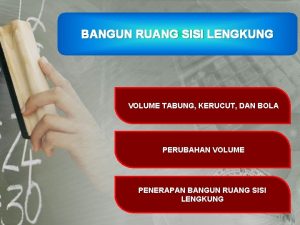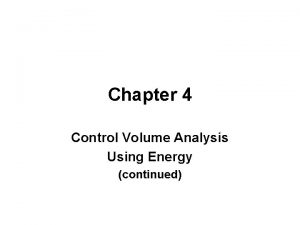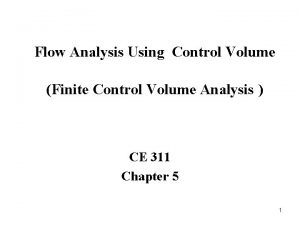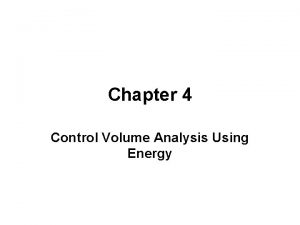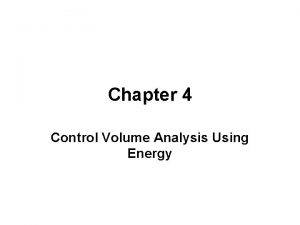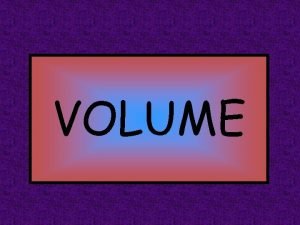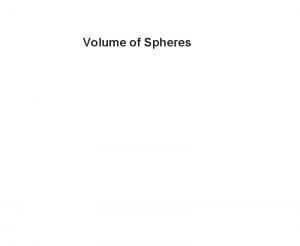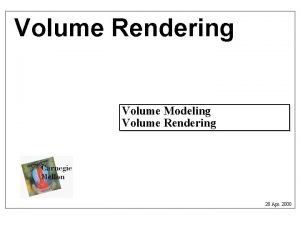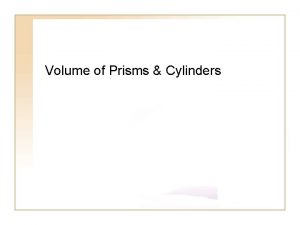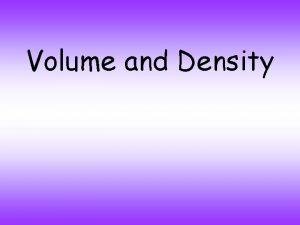Chapter 4 Control Volume Analysis Using Energy continued



















- Slides: 19

Chapter 4 Control Volume Analysis Using Energy (continued)

Learning Outcomes ►Distinguish between steady-state and transient analysis, ►Distinguishing between mass flow rate and volumetric flow rate. ►Apply mass and energy balances to control volumes. ►Develop appropriate engineering models to analyze nozzles, turbines, compressors, heat exchangers, throttling devices. ►Use property data in control volume analysis appropriately.

Mass Rate Balance time rate of change of mass contained within the control volume at time rate of flow of mass in across inlet i at time rate of flow of mass out across exit e at time t (Eq. 4. 2)

Determine the amount of water In tank after 1 hour

Energy Rate Balance time rate of change of the energy contained within the control volume at time t net rate at which energy is being transferred in by heat transfer at time t net rate at which energy is being transferred out by work at time t net rate of energy transfer into the control volume accompanying mass flow (Eq. 4. 9)

Evaluating Work for a Control Volume The expression for work is (Eq. 4. 12) where accounts for work associated with rotating shafts, displacement of the boundary, and electrical effects. ► is the flow work at exit e. ► ► is the flow work at inlet i.

Control Volume Energy Rate Balance (One-Dimensional Flow Form) Using Eq. 4. 12 in Eq. 4. 9 (Eq. 4. 13) For convenience substitute enthalpy, h = u + pv (Eq. 4. 14)

Control Volume Energy Rate Balance (One-Dimensional Flow Form) In practice there may be several locations on the boundary through which mass enters or exits. Multiple inlets and exits are accounted for by introducing summations: (Eq. 4. 15) Eq. 4. 15 is the accounting balance for the energy of the control volume.

Turbines ►Turbine: a device in which power is developed as a result of a gas or liquid passing through a set of blades attached to a shaft free to rotate.

Determine the Velocity At each exit duct where V is velocity v is specific volume


Turbine Modeling Eq. 4. 20 a ►If the change in kinetic energy of flowing matter is negligible, ½(V 12 – V 22) drops out. ►If the change in potential energy of flowing matter is negligible, g(z 1 – z 2) drops out. ►If the heat transfer with surroundings is negligible, drops out.

Heat Exchangers ►Direct contact: A mixing chamber in which hot and cold streams are mixed directly. ►Tube-within-a-tube counterflow: A gas or liquid stream is separated from another gas or liquid by a wall through which energy is conducted. Heat transfer occurs from the hot stream to the cold stream as the streams flow in opposite directions.

Heat Exchanger Modeling (Eq. 4. 18) ► ►If the kinetic energies of the flowing streams are negligible, (Vi 2/2) and (Ve 2/2) drop out. ►If the potential energies of the flowing streams are negligible, gzi and gze drop out. ►If the heat transfer with surroundings is negligible, drops out.

4 3




 Control volume analysis
Control volume analysis Energy energy transfer and general energy analysis
Energy energy transfer and general energy analysis Energy energy transfer and general energy analysis
Energy energy transfer and general energy analysis Work and energy section 2 describing energy
Work and energy section 2 describing energy Part 4 forms of energy continued
Part 4 forms of energy continued Control volume vs control surface
Control volume vs control surface Control volume vs control surface
Control volume vs control surface Konsep volume atur
Konsep volume atur Control volume analysis
Control volume analysis Section 3 using heat worksheet answers
Section 3 using heat worksheet answers Chapter 8 section 3: cellular respiration
Chapter 8 section 3: cellular respiration How to calculate break even sales
How to calculate break even sales Basic assumptions of cvp analysis
Basic assumptions of cvp analysis Stroke volume
Stroke volume Edv and preload
Edv and preload Solute vs solvent
Solute vs solvent Lung capacity
Lung capacity Volume tabung kerucut
Volume tabung kerucut Large-volume parenterals
Large-volume parenterals Chapter 7 energy conservation of energy
Chapter 7 energy conservation of energy
